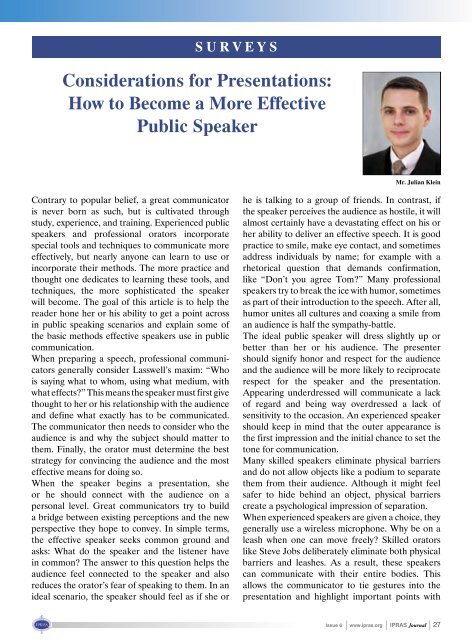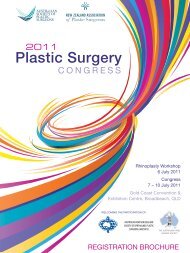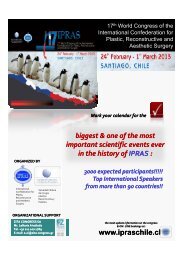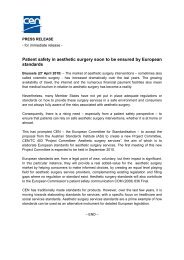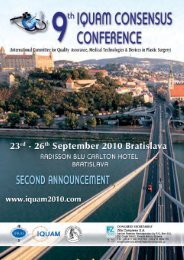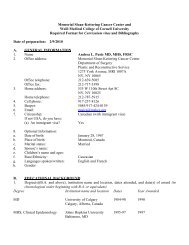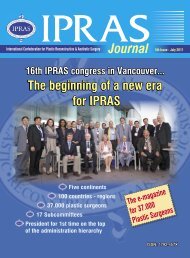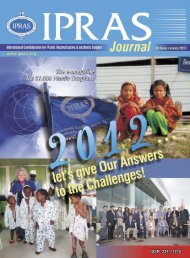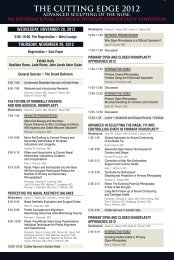Download pdf file - IPRAS
Download pdf file - IPRAS
Download pdf file - IPRAS
- No tags were found...
You also want an ePaper? Increase the reach of your titles
YUMPU automatically turns print PDFs into web optimized ePapers that Google loves.
S U R V E Y SConsiderations for Presentations:How to Become a More EffectivePublic SpeakerMr. Julian KleinContrary to popular belief, a great communicatoris never born as such, but is cultivated throughstudy, experience, and training. Experienced publicspeakers and professional orators incorporatespecial tools and techniques to communicate moreeffectively, but nearly anyone can learn to use orincorporate their methods. The more practice andthought one dedicates to learning these tools, andtechniques, the more sophisticated the speakerwill become. The goal of this article is to help thereader hone her or his ability to get a point acrossin public speaking scenarios and explain some ofthe basic methods effective speakers use in publiccommunication.When preparing a speech, professional communicatorsgenerally consider Lasswell’s maxim: “Whois saying what to whom, using what medium, withwhat effects?” This means the speaker must first givethought to her or his relationship with the audienceand define what exactly has to be communicated.The communicator then needs to consider who theaudience is and why the subject should matter tothem. Finally, the orator must determine the beststrategy for convincing the audience and the mosteffective means for doing so.When the speaker begins a presentation, sheor he should connect with the audience on apersonal level. Great communicators try to builda bridge between existing perceptions and the newperspective they hope to convey. In simple terms,the effective speaker seeks common ground andasks: What do the speaker and the listener havein common? The answer to this question helps theaudience feel connected to the speaker and alsoreduces the orator’s fear of speaking to them. In anideal scenario, the speaker should feel as if she orhe is talking to a group of friends. In contrast, ifthe speaker perceives the audience as hostile, it willalmost certainly have a devastating effect on his orher ability to deliver an effective speech. It is goodpractice to smile, make eye contact, and sometimesaddress individuals by name; for example with arhetorical question that demands confirmation,like “Don’t you agree Tom?” Many professionalspeakers try to break the ice with humor, sometimesas part of their introduction to the speech. After all,humor unites all cultures and coaxing a smile froman audience is half the sympathy-battle.The ideal public speaker will dress slightly up orbetter than her or his audience. The presentershould signify honor and respect for the audienceand the audience will be more likely to reciprocaterespect for the speaker and the presentation.Appearing underdressed will communicate a lackof regard and being way overdressed a lack ofsensitivity to the occasion. An experienced speakershould keep in mind that the outer appearance isthe first impression and the initial chance to set thetone for communication.Many skilled speakers eliminate physical barriersand do not allow objects like a podium to separatethem from their audience. Although it might feelsafer to hide behind an object, physical barrierscreate a psychological impression of separation.When experienced speakers are given a choice, theygenerally use a wireless microphone. Why be on aleash when one can move freely? Skilled oratorslike Steve Jobs deliberately eliminate both physicalbarriers and leashes. As a result, these speakerscan communicate with their entire bodies. Thisallows the communicator to tie gestures into thepresentation and highlight important points withIssue 6 www.ipras.org <strong>IPRAS</strong> Journal 27


